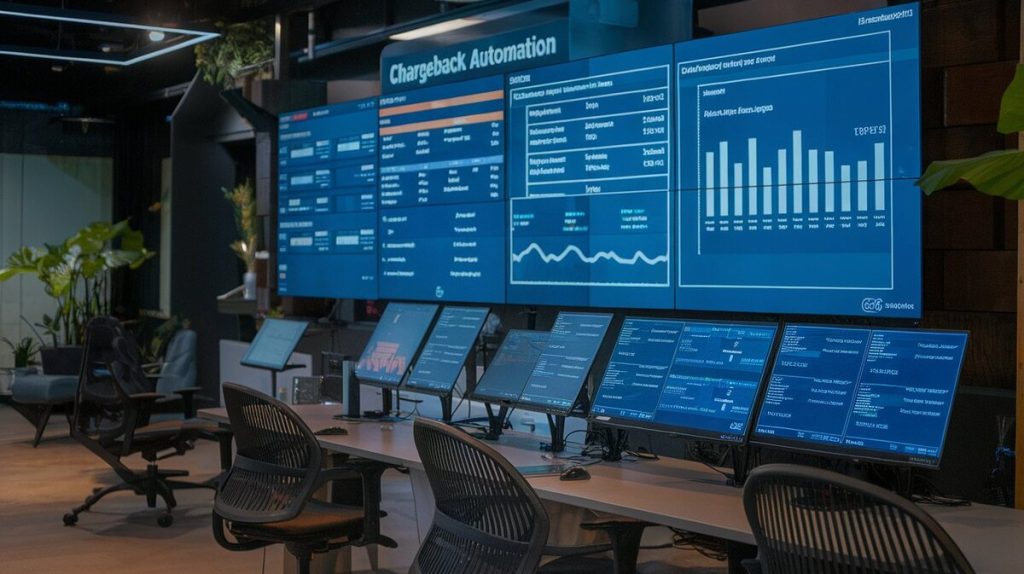Chargebacks pose significant challenges for businesses, particularly as online transactions surge. According to Mastercard, global chargeback costs could reach $125 billion by 2023 due to fraudulent claims and disputes. Chargeback automation addresses this by streamlining the dispute management process, reducing costs, and improving efficiency. This article explores the essentials of chargeback automation, its benefits, and the leading tools available.
What is Chargeback Automation?
Chargeback automation uses software solutions to manage chargeback processes without manual intervention. It automates tasks such as evidence collection, dispute filing, and tracking case outcomes.
Key Stages of Chargeback Automation:
- Evidence Collection: Automated systems gather transaction data, customer information, and relevant documentation to build a strong case. Advanced tools can enrich this data with third-party information, such as IP addresses or behavioral patterns.
- Dispute Representment: Automation tools generate dispute responses tailored to specific cases, optimizing them for relevant reason codes and payment networks.
- Submission and Optimization: Automated systems submit the dispute to the issuing bank and track outcomes. Advanced platforms continuously learn from each case to improve future success rates.
Benefits of Chargeback Automation
Chargeback automation provides several critical benefits:
- Efficiency: Automated systems process disputes faster than manual methods. This is crucial for businesses managing thousands of chargebacks each month, especially during peak shopping seasons.
- Cost Savings: Automation reduces the manual labor involved in dispute management, lowering operational costs. Visa estimates that automation can reduce chargeback-related costs by up to 30%.
- Scalability: Automation systems are scalable, adapting to business growth and fluctuating transaction volumes without requiring significant additional investment.
- Accuracy: Automated systems reduce human error, ensuring that each dispute is handled consistently and accurately, significantly improving a business’s chargeback win rate.

Key Features of Effective Chargeback Automation Solutions
To maximize the benefits of chargeback automation, it is essential to choose a solution with advanced features:
- AI and Machine Learning: These technologies enable systems to learn from previous cases and optimize dispute responses over time. Businesses using AI-driven chargeback solutions see a 20% improvement in dispute win rates..
- Integration and API Capabilities: A reliable chargeback automation tool should integrate seamlessly with existing payment processing systems like Stripe or Braintree. This ensures a smooth flow of data and reduces the complexity of managing multiple platforms.
- Dynamic Dispute Representment: Advanced tools create custom dispute responses based on specific case details, improving the chances of success.
Table 1: Comparison of Chargeback Automation Features
| Feature | Basic Automation | Advanced Automation |
|---|---|---|
| Evidence Collection | Transaction Data | Enriched with Third-Party Data |
| Dispute Representment | Template-Based | Dynamic, Case-Specific Arguments |
| Submission and Reporting | Manual or Semi-Automated | Fully Automated with Continuous Optimization |
| AI and Machine Learning | Not Available | Integrated for Continuous Learning |
| API Integration | Limited | Full API Integration with Payment Systems |
Popular Chargeback Automation Platforms
Several platforms lead in chargeback automation, each offering unique features:
Merchanto.org is an official partner of Visa and MasterCard in chargeback prevention. Merchanto.org provides comprehensive tools for managing disputes, backed by direct support from these major card networks. Visit Merchanto.org for more details.
Other Notable Platforms:
- Chargehound: Offers an AI-driven system that automatically handles chargebacks with minimal human intervention.
- Justt.ai: Focuses on using machine learning to optimize chargeback management processes continuously.
- Stripe Radar: Provides fraud prevention and chargeback management as part of Stripe’s broader payment processing platform.
Table 2: Overview of Leading Chargeback Automation Platforms
| Platform | Key Features | API Integration | AI & Machine Learning | Notable Clients |
|---|---|---|---|---|
| Merchanto.org | Official partner of Visa & MasterCard | Yes | Yes | Small to Large Enterprises |
| Chargehound | Fully automated dispute management | Yes | Yes | eCommerce, SaaS Companies |
| Justt.ai | Continuous optimization with AI | Yes | Yes | Financial Institutions |
| Stripe Radar | Integrated with Stripe Payments | Yes | Yes | SMEs and Large Businesses |
Case Studies and Real-World Applications
Chargeback automation has proven its value across various industries. Below are examples of businesses that have successfully implemented these solutions:
- eCommerce Retailer: A major eCommerce retailer integrated a chargeback automation tool with their payment processor. This resulted in a 25% reduction in chargeback losses within the first year due to improved dispute accuracy and faster processing times.
- Subscription Service: A digital streaming service used AI-driven chargeback automation to handle the increasing number of disputes related to subscription cancellations. The automation system reduced dispute handling time by 40%, allowing the company to focus more on customer service.
Table 3: Impact of Chargeback Automation in Different Industries
| Industry | Pre-Automation Chargeback Rate | Post-Automation Chargeback Rate | Cost Savings (%) | Dispute Resolution Time Reduced By (%) |
|---|---|---|---|---|
| eCommerce | 1.5% | 1.1% | 25% | 30% |
| Digital Streaming | 2.3% | 1.7% | 20% | 40% |
| Travel and Hospitality | 3.1% | 2.2% | 35% | 25% |

Future of Chargeback Automation
The future of chargeback automation lies in AI and robotics. Companies using AI-powered automation can achieve up to 98% automation in their chargeback processes. As these technologies evolve, higher efficiency, better fraud detection, and more accurate dispute resolution are expected.
However, the growing complexity of global transactions will continue to present challenges. Businesses must adapt to new fraud patterns, changing regulations, and customer expectations. Implementing a flexible, scalable chargeback automation system will be crucial for staying ahead of these challenges.
Conclusion
Chargeback automation is essential for businesses in today’s digital economy. By automating the dispute management process, companies can protect revenue, reduce operational costs, and improve customer satisfaction. With the right tools and partners businesses can significantly enhance their chargeback management strategies.
Summary of Benefits:
- Reduced Costs: Automation can cut chargeback management costs by up to 30%.
- Increased Efficiency: Automating the dispute process can reduce resolution times by up to 40%.
- Scalability: Automated systems grow with your business, handling increased transaction volumes without additional overhead.
Chargeback automation transforms a cumbersome process into a streamlined operation that drives success in a competitive marketplace.



